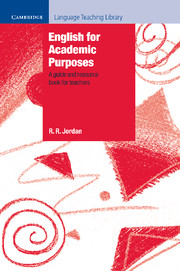Book contents
- Frontmatter
- Contents
- List of figures
- List of abbreviations
- Acknowledgements
- Introduction
- Part I English for Academic Purposes and study skills
- Part II Study skills and practice (EGAP)
- Part III English for Specific Academic Purposes
- Appendices
- 1 Recommended books and journals
- 2 Educational technology
- 3 BALEAP, and the Survey
- 4 EAP exams and examining bodies
- References
- Subject index
- Author index
2 - Educational technology
Published online by Cambridge University Press: 10 November 2010
- Frontmatter
- Contents
- List of figures
- List of abbreviations
- Acknowledgements
- Introduction
- Part I English for Academic Purposes and study skills
- Part II Study skills and practice (EGAP)
- Part III English for Specific Academic Purposes
- Appendices
- 1 Recommended books and journals
- 2 Educational technology
- 3 BALEAP, and the Survey
- 4 EAP exams and examining bodies
- References
- Subject index
- Author index
Summary
The language laboratory
A number of institutions have language laboratories which are under-used. This is wasteful of an excellent resource that can be used either for group sessions or for self-access/library-mode purposes. Apart from the array of listening/speaking material available commercially, other material can be developed to provide a bank of EGAP/ESAP cassettes, worksheets and folders (see Chapter 18). The material would need to be divided into categories: e.g.
pronunciation, stress and intonation
listening and reading
listening and speaking
listening and comprehension (with some writing)
listening and note-taking
grammar
EGAP
ESAP (various subjects)
and levels (perhaps colour-coded for easy recognition): e.g.
a elementary
b lower intermediate
c upper intermediate
d advanced
Students need guidance in using the language laboratory in order to obtain the maximum benefit. This is, perhaps, best achieved by an introductory, practical session, combined with printed advice to act as a reminder, an example of which is given below.
WORKING IN THE LANGUAGE LABORATORY
Use the language laboratory for about 30 minutes at a time. It is difficult to work in a concentrated way for longer, so take a short break after half-an-hour.
Procedure for using a tape-course:
REMEMBER
– Most courses are designed to give practice in listening and speaking (with very little reading).
– If you look at the book all the time while listening to the tape, you are really practising reading – and this will defeat the purpose of the course.
[…]
- Type
- Chapter
- Information
- English for Academic PurposesA Guide and Resource Book for Teachers, pp. 350 - 358Publisher: Cambridge University PressPrint publication year: 1997



